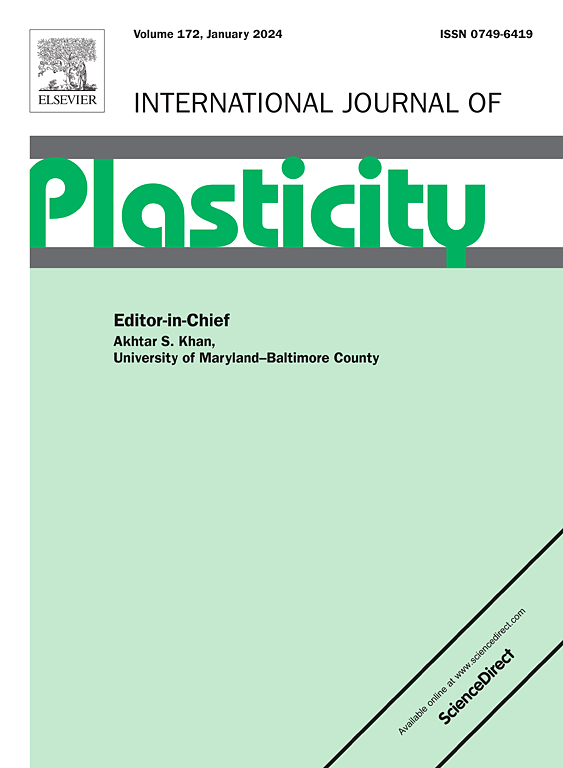通过位移级联的原子模拟,利用相场建模研究 BCC 难熔高熵合金的辐照硬化行为
IF 12.8
1区 材料科学
Q1 ENGINEERING, MECHANICAL
引用次数: 0
摘要
难熔高熵合金(RHEAs)具有优异的抗辐照性能,因此有望应用于先进的核反应堆。本研究通过分子静力学(MS)和分子动力学(MD)模拟,研究了由位移级联的原初敲击原子(PKAs)诱导的 RHEAs 中的局部不稳定堆积断层能(USFE)。在这些原子模拟的基础上,建立了一个相场位错动力学(PFDD)模型,采用随机统计方法将化学成分波动和位移级联对 RHEAs 中局部 USFE 的影响纳入其中。利用该 PFDD 模型,研究了 WTaCrV 中边缘位错和螺钉位错的平面运动以及螺钉位错的交叉滑移行为。结果表明,级联区可以有效地钉住边缘位错,并阻碍螺钉位错中扭结对的成核,从而导致辐照硬化。然而,由于 WTaCrV 的化学成分波动导致局部 USFE 值较低,这使得针刺点附近的边缘位错段会向外弯曲,拖拽针刺位错段,从而降低针刺效果。此外,低局部 USFE 会促进螺旋位错中扭结对的成核和迁移。此外,在螺旋位错交叉滑移的情况下,由于非平面的扭结对向习性平面退缩,辐照硬化得到缓解。这些模拟结果揭示了 RHEAs 中抗辐照硬化的中尺度内部机制。根据这些发现,提出了描述位错运动和辐照硬化的中尺度理论模型,并通过实验进行了验证。有了这些模型,就可以预测其他 RHEA 的辐照硬化行为。这些发现可以指导先进抗辐照 RHEAs 的设计和制备,并有助于开发更先进的理论模型和模拟方法。本文章由计算机程序翻译,如有差异,请以英文原文为准。
Investigate irradiation hardening behavior in BCC refractory high-entropy alloys using phase-field modeling informed by atomistic simulations of displacement cascades
Refractory high-entropy alloys (RHEAs) exhibit excellent anti-irradiation properties, making them promising candidates for application in advanced nuclear reactors. In this study, molecular statics (MS) and molecular dynamics (MD) simulations are conducted to investigate the local unstable stacking fault energy (USFE) in RHEAs induced by primary knock-on atoms (PKAs) of displacement cascades. Based on these atomistic simulations, a phase-field dislocation dynamics (PFDD) model is developed, incorporating the effects of chemical composition fluctuations and displacement cascades on local USFE in RHEAs using a random statistical approach. Using this PFDD model, the planar motion of edge and screw dislocations, as well as the cross-slip behavior of screw dislocations, in WTaCrV are examined. The results indicate that the cascade region can effectively pin edge dislocations and hinder the nucleation of kink pairs in screw dislocations, leading to irradiation hardening. However, the low local USFE caused by chemical composition fluctuations in WTaCrV allows edge dislocation segments near pinning sites to bow out, dragging pinned dislocation segments and reducing the pinning effect. Additionally, the low local USFE promotes the nucleation and migration of kink pairs in screw dislocations. Furthermore, for the case of screw dislocation cross-slip, the irradiation hardening is alleviated as nonplanar kink pairs recede to the habit plane. These simulation results reveal the mesoscale internal mechanisms underlying anti-irradiation hardening in RHEAs. Based on these findings, mesoscale theoretical models describing dislocation motion and irradiation hardening are proposed, and they are verified experimentally. With these models, the irradiation hardening behavior of other RHEAs can be predicted. These findings can guide the design and preparation of advanced anti-irradiation RHEAs and contribute to the development of upscaled theoretical models and simulation methods.
求助全文
通过发布文献求助,成功后即可免费获取论文全文。
去求助
来源期刊

International Journal of Plasticity
工程技术-材料科学:综合
CiteScore
15.30
自引率
26.50%
发文量
256
审稿时长
46 days
期刊介绍:
International Journal of Plasticity aims to present original research encompassing all facets of plastic deformation, damage, and fracture behavior in both isotropic and anisotropic solids. This includes exploring the thermodynamics of plasticity and fracture, continuum theory, and macroscopic as well as microscopic phenomena.
Topics of interest span the plastic behavior of single crystals and polycrystalline metals, ceramics, rocks, soils, composites, nanocrystalline and microelectronics materials, shape memory alloys, ferroelectric ceramics, thin films, and polymers. Additionally, the journal covers plasticity aspects of failure and fracture mechanics. Contributions involving significant experimental, numerical, or theoretical advancements that enhance the understanding of the plastic behavior of solids are particularly valued. Papers addressing the modeling of finite nonlinear elastic deformation, bearing similarities to the modeling of plastic deformation, are also welcomed.
 求助内容:
求助内容: 应助结果提醒方式:
应助结果提醒方式:


